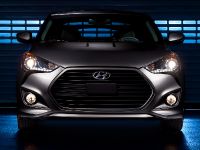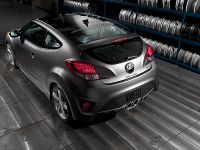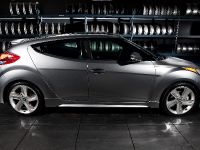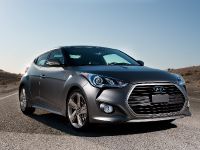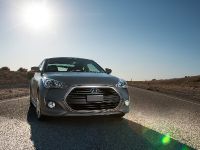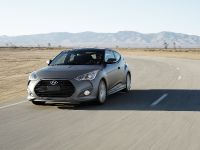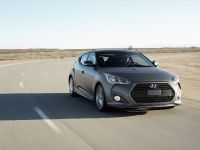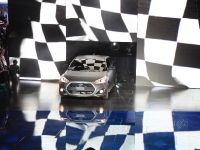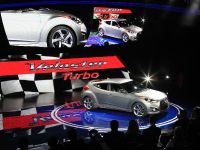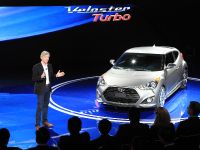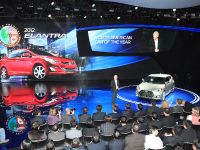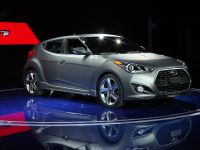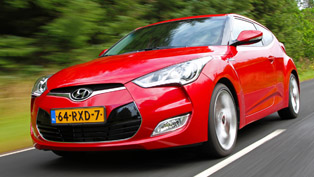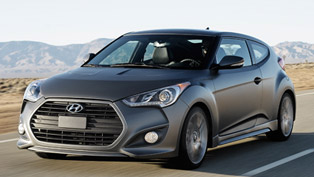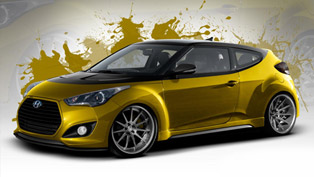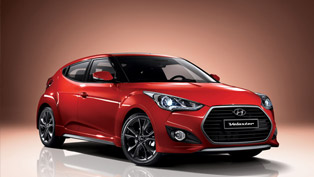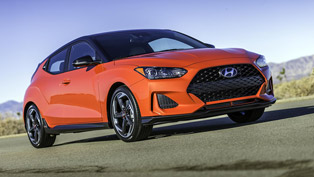2012 Hyundai Veloster Turbo
Hyundai unveiled today the all-new 2013 Veloster Turbo at the North American International Auto Show (NAIAS). Veloster Turbo is armed with 201 horsepower (248 kW). The vehicle is powerful, high-tech and fuel-efficient and all this makes it the ultimate innovation in the sport coupe segment. The 2013 Veloster Turbo will be in dealerships in the summer of 2012 packed with unique sport-tuned steering and suspension hardware set.
The new Veloster Turbo is equipped with 1.6-liter turbocharged GDI four-cylinder engine in which produces 201 horsepower at 6000 rpm and 195 lb-ft (264 Nm) of torque from 1750 – 4500 rpm with regular fuel. More importantly the vehicle is estimated to deliver 27 mpg city and best-in-class 38 mpg highway for manual transmission models! The 1.6-liter Gamma turbocharged engine includes a twin-scroll turbocharger that when combined with the GDI system, results in instantaneous power delivery. Although twin-scroll turbochargers have traditionally been used on more expensive high performance engines, Hyundai has brought this technology down its line-up from the Sonata 2.0T. In particular, twin-scroll turbocharger designs have two exhaust gas inlets divided by split walls inside the turbine housing, with both gas passages controlled by a waste-gate. A twin-scroll turbo recovers even more energy from the exhaust than a single-scroll turbocharger, thanks to a divided manifold. The twin-scroll design separates the cylinders whose exhaust gas pulses interfere with each other, and thus resulting in improved pressure distribution in the exhaust ports and a more efficient delivery of exhaust gas energy to the turbocharger's turbine. Another important result is the improved pressure distribution in the exhaust ports and a more efficient delivery of exhaust gas energy to the turbocharger's turbine. This in turn allows greater valve overlap, resulting in an enhanced quality and quantity of the air charge entering each cylinder. Additionally the twin-scroll turbocharger design includes other benefits over traditional, single-scroll turbocharging systems, such as improved combustion efficiency, low engine-speed efficiency, kinetic exhaust gas energy is not wasted or trapped, cooler cylinder temperatures, lower exhaust temperatures, leaner air/fuel ratio, better pressure distribution in the exhaust ports and more efficient delivery of exhaust gas energy to the turbocharger's turbine. Furthermore Veloster's twin-scroll turbo has great handling of exhaust gas separation at the turbine leading to improved low-end torque and faster transient torque response. Thanks to the integrated stainless-steel turbine housing with the exhaust manifold, not only is the weight and cost of the casting reduced, but also is the durability of the turbine housing also improved. Moreover heat energy recovery and thus turbo efficiency is significantly improved based on the fact that a traditional two-piece design effectively insulates some of the heat energy at the joint/gasket area.
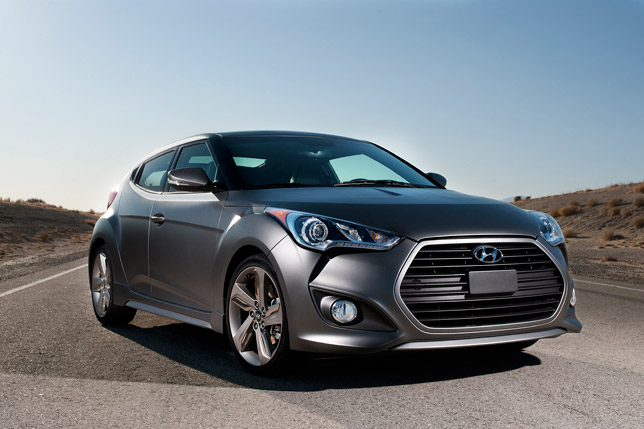
Furthermore the specific GDI fuel delivery system contributes to improved fuel efficiency and lower emissions. The fuel is injected by a camshaft-driven, high pressure pump that operates at pressures up to 2175 psi. Direct injection also utilizes a higher-than-normal 9.5 compression ratios, while achieving a best-in-class 125.6 horsepower-per-liter. The piston heads are "dished" to increase combustion efficiency in the cylinder.
Veloster Turbo's is uniquely designed. The inspiration was a custom high-performance sport bike. Moreover Hyundai designers have removed the Veloster's trapezoidal center exhaust and replaced it with two larger free flowing circular pipes. These new pipes and the new intake manifold also allowed engineers to give the engine a more robust sound. Drivers will also appreciate that the Veloster Turbo will be available in a Hyundai first Matte Gray paint. In addition a set of 18-inch gray wheels with chrome inserts completes the Veloster Turbo's classy style. Another important feature is that Veloster Turbo includes a quicker ratio steering rack and a revised steering calibration to match, which both give drivers precise cornering, feedback and control. All Veloster Turbo's ride on Kumho Solus KH25 215/40R18 85V tires designed to extract the best performance out of the car without compromising the ride. Good news is that all Velosters are fitted with a McPherson strut front suspension, coil springs, gas shock absorbers and a 24 mm diameter front stabilizer. Additionally, the rear suspension is a light-weight V-torsion beam, a Hyundai-first with an integrated 23 mm stabilizer bar to allow bracing of the arms for greater stiffness and to further control body roll. In order to bring more comfort, the rear suspension also uses monotube shock absorbers. All Velosters feature electric power steering that adjusts assistance instantly to changing driving conditions while improving fuel economy over a conventional steering system. Veloster's turning diameter of 34.1 feet is better than Mini's 35.1 feet and Mini Clubman's 36.1 feet.
And if you wonder about the interior, it features full leather seats with the word "Turbo" stitched into the seatbacks. An exclusive Supervision Cluster offers the driver information in a larger, clearer and more interactive format. This is due to the Supervision Cluster's two TFT screens located between the tachometer and the speedometer. As a standard there are two heated front seats.
In order to handle the power enhancements Veloster Turbo is paired with a standard six-speed manual transmission or a six-speed automatic transmission. The manual features a wider gear ratio spread (5.71 vs. 5.25) to handle the additional torque output. The high-revving turbo helps during acceleration, especially at highway speeds. The Veloster Turbo is mated to a six-speed automatic transmission with steering wheel-mounted paddle-shifter and and Shiftronic® controls rather than the base Vesloster's EcoShift DCT. This is due to the increased torque output from the 1.6-liter Turbocharged-GDI engine. The gear ratio spread on the automatic transmission is slightly narrower than the DCT (6.0 vs. 6.38). A narrower spread maintains the engine in the power band when going from one gear to the other. The base Veloster's EcoShift DCT is tuned for fuel efficiency and not for the performance feel needed for the Veloster Turbo.
At just 2,800 pounds, Veloster sets priority on weight efficiency, whcih allows the car Turbo to deliver a great combination of agility, performance, and fuel efficiency. The overall dimensions of the vehicle are 104.3-inch wheelbase, 167.3 inches long and 71.1 inches wide.
Of course, all Velosters have an exceptional level of standard safety features for the sporty car segment highlighted by a Vehicle Stability Management (VSM) system, which optimally manages ESC (Electronic Stability Control) and the Motor-Driven electric Power Steering (MDPS). First of all, VSM works to control two effects. The first is when a driver accelerates or brakes on a split-mu surface (slippery on one side, dry pavement on the other) and the vehicle wants to pull in one direction. In addition VSM detects this condition and sends a signal to the MDPS to apply steering assist. It counters the pull and automatically provides up to eight Newton meters of counter steering and reacts the same way during sudden lane changes or fast cornering. Further advantages concerning the safety are the six airbags—including dual front, front seat-mounted side-impact, and front and rear side curtain airbags; a state-of-the-art braking package - the package includes four-wheel disc brakes and an Anti-Lock Braking System (ABS) including Brake Assist, which provides maximum braking force when a panic stop is detected; and Electronic Brake-force Distribution (EBD), to automatically adjust the braking force to front and rear axles based on vehicle loading conditions.
The vehicle also comes standard with a multifunction seven-inch touch-screen display, which now makes it more interactive and entertaining. In addition there is included Pandora internet radio , Gracenote MediaVOCS® technology, a standard 450-watt Dimension Premium Audio system with eight speakers including an eight-inch subwoofer, external amplifier and iPod®/USB/auxiliary input jacks; XM Satellite Radio interface; a Bluetooth hands-free phone system with voice recognition, address book download and audio streaming; onboard navigation. And at last but not least it also features the unique Hyundai Blue Link Technology. As part of the Blue Link launch, Hyundai also will provide Blue Link Assurance on Blue Link-equipped vehicles, which include core safety services for an introductory period. These key safety services include: Automatic Crash Notification (ACN) and Assistance, SOS Emergency Assistance, and Enhanced Roadside Assistance.
Eventually Veloster Turbo's is painted in an exclusive Matte Gray. Later all 2013 Velosters will be available in colors that fit the cars "own-it" attitude and characteristics of a long-distance runner, including Elite White. There will also be interior color choices such as Graphite Black Graphite Black with Blue accents and headliner graphics for non-panoramic sunroof models.
VELOSTER TURBO VERSUS ITS RIVALS
|
Base Engine |
2013 Veloster Turbo |
2012 Civic Coupe Si |
2012 GTI |
2012 Cooper S |
2012 Clubman S |
|
Displacement |
1.6-liter Turbo |
2.4-liter |
2.0-liter Turbo |
1.6-liter Turbo |
1.6-liter Turbo |
|
Horsepower (est.) |
201 @ 6000 |
201@ 7000 |
200@ 5100 |
181@ 5500 |
181@ 5500 |
|
Torque (lb.-ft.) (est.) |
195 lb–ft @ 1750 – 4500 |
170@4400 |
207@1800 |
177@1600–5000 |
177@1600–5000 |
|
Specific Output |
125.6 |
83.8 |
100.0 |
113.1 |
113.1 |
|
Transmission |
6 M/T or A/T |
6 M/T or A/T |
6 M/T or DCT |
6 M/T or A/T |
6 M/T or A/T |
|
Fuel Economy M/T A/T |
27/38 (est.) TBD/TBD |
22/31 N/A |
21/31 24/33 |
26/34 27/35 |
26/34 27/35 |
|
Curb Weights M/T A/T |
2,800 2,888 |
2,877 N/A |
3,034 (2D) 3,080 (2D) |
2,668 2,712 |
2,833 2,877 |
|
Weight-to-Power Ratio M/T A/T |
14.0 14.4 |
14.3 N/A |
15.2 15.4 |
14.7 15.0 |
15.7 15.9 |
Source: Hyundai
